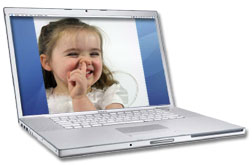 #LFMF I recently spoke about Cheating Death by PowerPoint to a group of businesspeople. I came in early, connected my laptop to the projector, opened up the title slide to my presentation, then proceeded to work the room. After chatting with folks for about twenty minutes, I glanced at the projection screen…and saw photographs of my sons drifting in and out of view. I had been away from the laptop for so long that my screensaver had activated, treating the audience to a slideshow of all of the pictures in iPhoto. Whoops. Luckily, I caught it before any embarrassing snapshots from my collection came up.
#LFMF I recently spoke about Cheating Death by PowerPoint to a group of businesspeople. I came in early, connected my laptop to the projector, opened up the title slide to my presentation, then proceeded to work the room. After chatting with folks for about twenty minutes, I glanced at the projection screen…and saw photographs of my sons drifting in and out of view. I had been away from the laptop for so long that my screensaver had activated, treating the audience to a slideshow of all of the pictures in iPhoto. Whoops. Luckily, I caught it before any embarrassing snapshots from my collection came up.
It turns out that I’m not the only one to have made this mistake. In fact, there are software solutions to help presenters to avoid this problem.
Mac Solution
It’s easy to disable the screen saver in System Preferences (choose Apple menu/System Preferences and click Desktop & Screen Saver) Set the timer to “Never.” You can also set up a “hot corner” to quickly disable your screen saver. A hot corner is activated when you move the cursor to one of the four corners of your monitor or laptop screen. To set up hot corners, choose Apple menu/System Preferences and click Desktop & Screen Saver, then click the Hot Corners button. Choose an action (Start Screen Saver or Disable Screen Saver) from the pop-up menu for a corner you want to use.
If that’s too much “programming” for you, you can download Caffeine, a free app that enables you to disable your screen saver by clicking on an icon on the Menu Bar.
Windows Solution
You can disable the screen saver by clicking Start/Settings/Control Panel. Double-click on the display icon, click on the screen saver tab, and select “None” as the screen saver choice.
There’s also a free utility called FlipSS that will enable you to toggle the screen saver on and off with one click. And this post from howtogeek.com tells you how to create a desktop shortcut for the utility.
